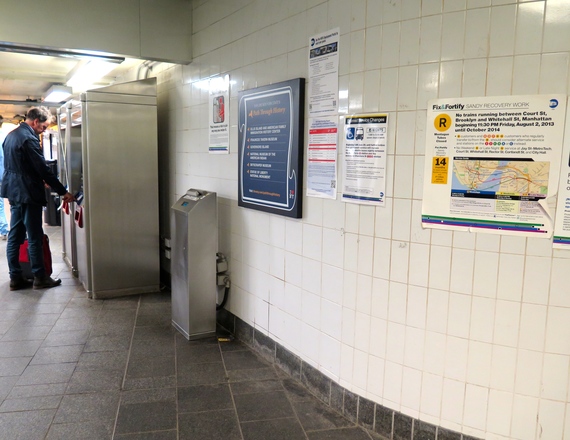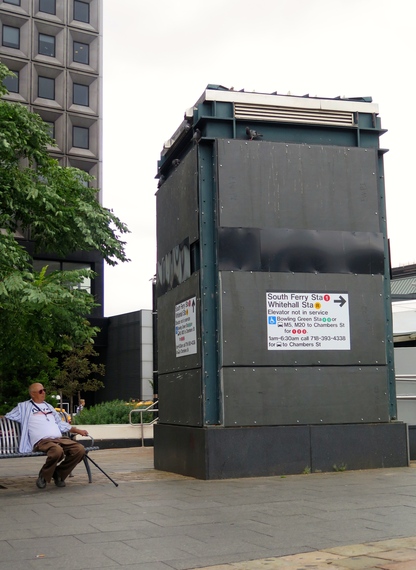The New York City transit system received a huge influx of passengers for the People's Climate March, organized by 350.org, an environmental organization led by a group including author Bill McKibben. Over 400,000 people participated in what is being noted as the world's largest climate demonstration in history. Participants came from all over the United States to demand "a world safe from the ravages of climate change."
On September 9th, the World Meteorological Organization (WMO) released a report, which confirms that climate change is not slowing down. It shows the highest year-over-year increase in atmospheric carbon dioxide in 30 years. The resulting warming effect known as "radiative forcing" increased by 34 percent between 1990 and 2013. This may mean more and more powerful storms are headed to NY.
Under former Mayor Michael Bloomberg, the first New York City Panel on Climate Change (NPCC) convened in 2008. This group of top climate and social scientists and risk management experts was tasked with creating climate projections and providing advice on how the city can adapt its infrastructure. The latest NPCC report published in June 2013 illustrated many threats to the city's transportation systems, including coastal storm surges, flash floods from increasingly heavy precipitation and heat waves, all of which need to be addressed with significant infrastructure improvements.
Over the last two years, the Metropolitan Transportation Authority (MTA) has been working on the "Fix & Fortify" initiative, undertaken by its Sandy Recovery and Resiliency Division. The Montague subway tube, which takes passengers on the R train from lower Manhattan to Brooklyn, recently reopened after being shut down for 13 months after Superstorm Sandy filled it with three million gallons of saltwater. Sandy's floodwaters extensively damaged nine subway tunnels in the New York transit system.
In May, the MTA asked six architectural and engineering firms to submit design proposals for better water pumps and other technology to mitigate flooding. When asked about the status of this design competition, Kevin Ortiz, a spokesperson for the MTA, said, "We are in the process of awarding a contract for South Ferry work. I cannot elaborate further at this time."
There is perhaps no more illustrative example of the vulnerability of low-lying subway stations in the city than the story of South Ferry. Sandy poured 15 million gallons of salt water into the station, destroying its entire power system. The 1 train had to bypass South Ferry station. What's more, the cost of repairs was a whopping $600 million. The station had been built only three years earlier, with a price tag of $545 million, according to the MTA website.
The MTA has replaced the electrical and mechanical systems at South Ferry, including adding resilient stainless steel and glass entrances, according to an April 2014 summary from the MTA's Capital Program Oversight Committee. Frank, a newspaper vendor, who works at the entrance to South Ferry terminal, points out that not everything is fixed: "The elevator for handicapped people is still broken."
The transportation authority is testing an array of new devices system-wide, such as removable flood control covers and raised concrete protective platforms for subway stairwells. An inflatable plug designed by the Department of Homeland Security could cork stations like wine bottles in the event of a storm surge. The MTA is prototyping covers that have bicycle racks on top of them for the sidewalk ventilation grates above stations and tunnels.
The work is hardly done. South Ferry is just one station of six in lower Manhattan, which were built with 540 vulnerable openings. Some experts worry that the extent and speed of redesign are insufficient. Klaus Jacob, a senior climate scientist at Columbia University's Lamont-Doherty Earth Observatory and an author on the NPCC reports warns in an email, "At the current speed of too little too slow, we are losing the race against the risks."
Klaus also points out that funding challenges are handicapping the MTA, which does not get its money from the City of New York. Rather, it depends on the state legislature to allocate funds, but the billions of dollars required have not been forthcoming. As a result, some of the most critical transit repairs and reinforcements remain undone.
NY could emulate the Netherlands, which offers a successful model of storm-proof infrastructure. More than half of the country sits below sea level and has had to protect itself from incoming waters for hundreds of years. Dutch political culture has evolved over the centuries to support robust preparation for natural disasters whereas the United States seems to be stuck in a cycle of putting all-hands-on-deck for disaster relief rather than the prevention of disasters in the first place.
The reopening of South Ferry Station and the Montague tube are small successes when measured against the amount of money, concrete and steel that need to be moved in order to avert another weather-related disaster in the future. Jacob wrote, "They may perhaps be operationally better, but in terms of engineered retrofits and capital projects, the vulnerability is still almost the same."
The People's Climate March was the blockbuster precursor to the UN Global Climate Summit that meets in NY this week. On September 23, experts from all over the globe are meeting to discuss the threat of climate change, new greenhouse gas emissions targets, and what is needed to protect major cities like New York.

